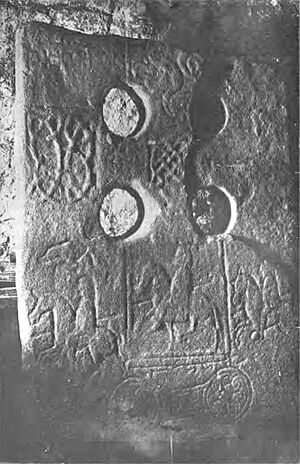Fordoun Stone facts for kids
Quick facts for kids The Fordoun Stone |
|
|---|---|

The Fordoun Stone
|
|
| Material | Old Red Sandstone |
| Size | 1.07 metres (3.5 ft) |
| Writing | Ogham script: VUN-MSETTORBBRE Roman script: Pidarnoin |
| Symbols |
|
| Discovered | 18th Century CE |
| Present location | Auchenblae, Aberdeenshire |
| Classification | Class II cross slab |
| Culture | Picto-Scottish |
The Fordoun Stone is a very old stone monument found in Scotland. It is a special type of stone called a Pictish cross slab. You can find it today in the Fordoun parish church, which is in a place called Auchenblae, Aberdeenshire.
Contents
What is the Fordoun Stone?
The Fordoun Stone is a large stone slab made from a type of rock called Old Red Sandstone. This stone is about 1.07 meters (or 3.5 feet) tall. It was carved a very long time ago by the Picts. The Picts were an ancient group of people who lived in eastern and northern Scotland during the late Iron Age and early Medieval periods.
This stone is known as a Class II Pictish cross slab. This means it has a Christian cross carved on one side and traditional Pictish symbols on the other. It's like a mix of two different cultures coming together.
Ancient Art and Symbols
The Fordoun Stone is covered with interesting carvings. On one side, there is a beautiful Celtic cross. This cross is decorated with fancy patterns that look like woven knots. These patterns are called interlaced knotwork.
On the other side of the stone, you can see some unique Pictish symbols. One of the main carvings is a hunting scene. It shows people or animals involved in a hunt. Another important symbol is the double disc and z-rod. This symbol looks like two circles joined together with a zig-zag line. We don't know exactly what all these symbols meant to the Picts, but they are very important clues about their beliefs and daily life.
The Mysterious Inscriptions
The Fordoun Stone also has writing on it, which is very rare for Pictish stones. Along the edges of the stone, there is writing in a special ancient alphabet called Ogham script. This script uses lines and notches carved into the stone. The Ogham inscription on the Fordoun Stone reads: VUN-MSETTORBBRE.
On the main face of the stone, there is another inscription. This one is written in Roman script, which is similar to the alphabet we use today. This Roman inscription says: Pidarnoin. Historians and language experts are still trying to fully understand what these ancient words mean. They might be names or important messages from the past.
How Was It Found?
The Fordoun Stone was discovered in the late 1700s, which is the 18th century. It wasn't found standing upright in a field like some other ancient stones. Instead, it was found being used as a paving stone inside the Fordoun Parish Church! Imagine walking on such an important piece of history without knowing it.
Once people realized what it was, the stone was carefully moved. Now, it stands proudly inside the church. This allows everyone to see and learn about this amazing piece of Pictish history. It helps us understand more about the people who lived in Scotland long, long ago.

